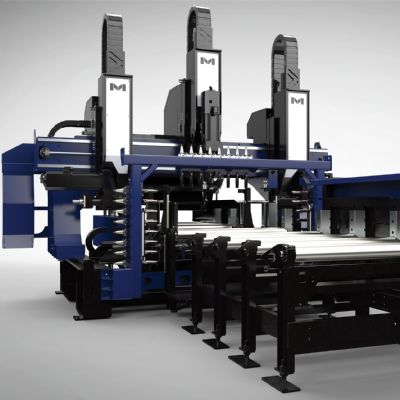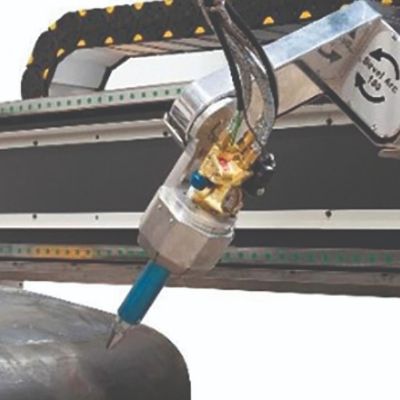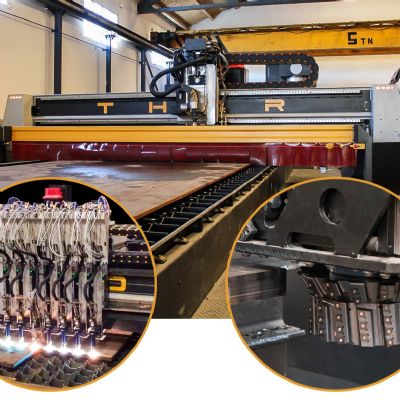Ripple is North America’s initial user of the new Powermax 65 Sync and its SmartSync torch, with Hypertherm having begun shipping Powermax 65-, 85- and 105-A Sync systems to partners in Asia, Australia and New Zealand, as well as South and Central America, in mid-October. Look for these systems in North America in mid-January. For users of previous technology, Hypertherm engineers have developed an adapter for Duramax and Duramax Lock torches.
Self-Taught and Always Seeking More
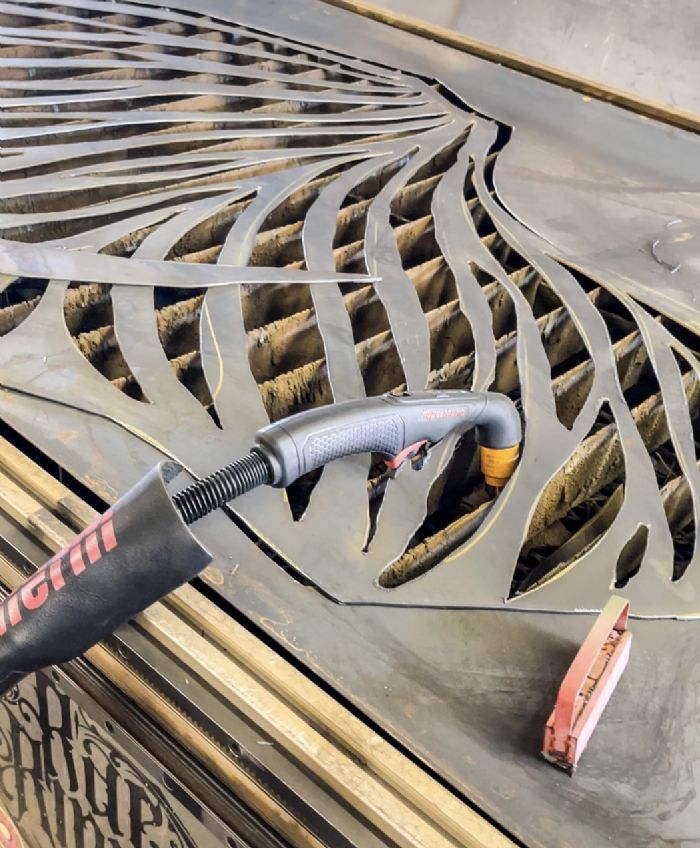 Ripple freehand-cut the butterfly wings displayed
at FABTECH with a Powermax65 Sync, showcasing both her ability and the
ability of the equipment. Having cut her cutting teeth on an older
hand-held PAC system, she took any opportunity possible to learn more,
including YouTube videos, online threads and her fabrication friends.
Making do with what she had, Ripple forged ahead.
Ripple freehand-cut the butterfly wings displayed
at FABTECH with a Powermax65 Sync, showcasing both her ability and the
ability of the equipment. Having cut her cutting teeth on an older
hand-held PAC system, she took any opportunity possible to learn more,
including YouTube videos, online threads and her fabrication friends.
Making do with what she had, Ripple forged ahead.
“When I first started creating metal art, I couldn’t afford new metal, so I only used scrap because that was all I could get my hands on,” she says. “Now I use a mix of scrap and new metal.”
That includes the ingredients for a piece Ripple was working on recently for a Houston-based liquor-store chain.
“It’s a bunny, made partly with new metal, and partly with scrap,” Ripple offers. “It’s nose and part of its face is built with pieces of old fire extinguishers that I had lying around, just like the wings at FABTECH, which included some fire-extinguisher scrap. I use a healthy mix of new metal, scrap metal, solid rock, rebar, old car exhausts—you name it. I use it all.”
The volume and variety of work tested Ripple’s original PAC system, and, as she says, she basically wore it out. With orders backing up, a friend of Ripple who owned a welding shop in town let her use a machine in his shop—Ripple’s introduction to Hypertherm and the Powermax45.
“I had no idea about the various machines and suppliers,” she recalls. “I learned everything I know about welding and cutting from YouTube! But it cut those fire extinguishers like butter, and I fell in love with it.”
This lit a fire in Ripple as to plasma cutting possibilities, and she started going live on Instagram to draw people in who knew anything about plasma cutting machines—“my plasma cutting fix,” she says.
“Changed the Way I Plasma-Cut”
That fix led to a new Hypertherm Powermax45 XP for Ripple.
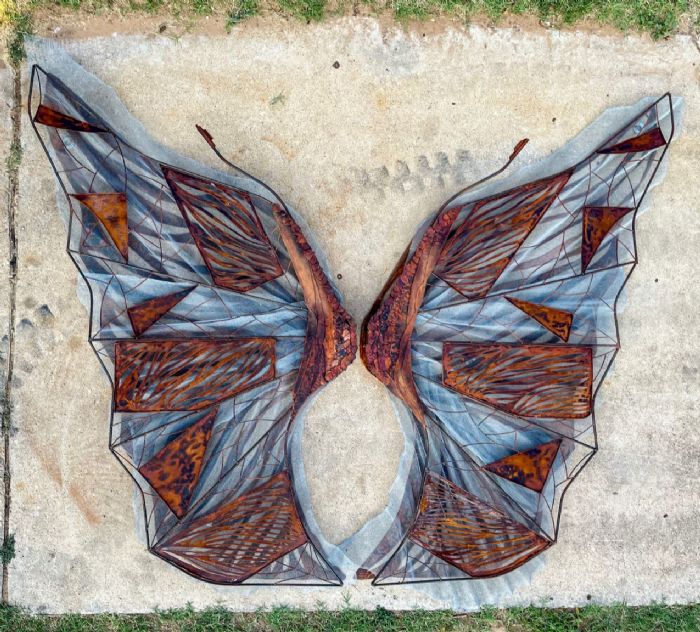 “It changed the way that I plasma-cut,” she says. “It has so many different settings and so many consumables that I could use. I literally could do anything with it (important considering the variety of her materials and projects).”
“It changed the way that I plasma-cut,” she says. “It has so many different settings and so many consumables that I could use. I literally could do anything with it (important considering the variety of her materials and projects).”
As happy as she was with this machine, Hypertherm sent Ripple the Powermax65 Sync to fabricate the wings for FABTECH.
“Mind you, I'm already in love with my plasma cutting machine, so how does it get any better than what I already have?” she wondered. “But with the very first cut…”
The new one-piece consumable cartridge made an immediate impression, with more quickly to follow.
“First off, the consumables aren’t consumables anymore,” Ripple says. “It’s a full cup—no consumable stack anymore, just the single cartridge, which blew my mind.”
“I placed a drag tip on the torch just to see what it could do, and there was no slag, none,” she continues. “Then just out of curiosity, I wanted to see everything that this machine could do. I literally was cutting anything and everything with it. As for cartridge life, I’m still using the same cup that I’ve had in the machine since this past summer. I cut up vehicles in my work, and I usually use one whole stack of consumables and then have about half a life left on a second stack after cutting a vehicle. Now, I cut two cars with one cartridge without a problem, and still have life.”
Subjecting the machine to harsh duty, Ripple claims no hiccups whatsoever, even during rough and curved cuts.
“Going around corners, that’s where plasma cutting usually can hang up, or start gouging and not penetrating through the material,” she explains, “or there are air-quality problems because the consumables are dirty. Then I’d have to pull everything out, clean it and put it all back together. With a regular consumables systems, codes are constantly thrown. But with the Powermax65 Sync, I haven’t gotten a single error code.”
“I don’t have to mess with things all the time, like changing consumables,” she continues. “We have a saying in Texas: Ride it hard and put it away wet—talking about driving equipment or working hard in the field, and leaving in a sweat. That’s exactly what I do with this machine and it still delivers every day. It’s a workhorse.”
Even on unique materials, such as expanded metal, Ripple sees no letup in machine performance.
“On an expanded-metal setting, the current on my old machine would break every once in a while—normal because it’s not cutting a solid sheet,” she says. “On expanded metal, the Sync system doesn’t break—it keeps cutting through every hole and every crevice.”
Advantages in Production Cutting
Ripple, producing art pieces and custom fabricated parts, senses how the torch performs during cutting and has yet to explore the data tracking and analysis functions of her Powermax Sync. For fabricators involved in volume production, the advantages of consumable cartridges, and data acquisition and analysis, are many. To understand why, MetalForming discussed the topic with Hypertherm’s Powermax Sync development group.
With the fabricating industry facing a shortage of skilled operators and new people coming in without expertise, equipment manufacturers are working to make the equipment easier to use. For decades, notes Brenda Mahoney, a marketing manager on Hypertherm’s Powermax Team, users of PAC machines in particular dealt with multiple consumable pieces that wore at different rates, and operators had to assemble consumables according to specific process needs—tough to do without years of experience.
“The users’ main struggle: knowing which parts to change and when,” Mahoney says. “Over time, users develop habits for changeout which may not be most effective. And, users can become confused over having to choose multiple parts to build the proper consumable stack for what they are cutting.”
This, too, often leads to ineffective results.
“In a five-piece consumable stack, the components ideally fit together to make beautiful plasma music,” offers Jesse Roberts, a mechanical engineering team leader on Hypertherm Powermax Team. “If a user changes only two of those components regularly while the others age, cutting can suffer. The swirl ring shortens due to all of the heat cycles, or insulation breaks down and causes shorts—there’s no simple way to tell what’s going on. The ability to change everything out as a cartridge ensures that all components remain fresh and in tune.”
Inventorying so many consumables creates another stressor in job-shop environments, where jobs require a variety of consumable stacks and physical space may be at a premium.
“Imagine having to manage the inventory of 20 consumable pieces due to multiple processes occurring with the cutting system,” says Soumya Mitra, a plasma-process engineering team leader. “Consumable cartridges make inventory management much easier.”
Valuable, Actionable Data
The advent of fabrication technology that provides data acquisition and analysis offers valuable insight for job-shop operations. Specifically, for those performing plasma cutting, such technology can be a game changer.
In this case, the SmartSync torch and cartridge communicate cartridge needs for the amount of air and current at certain times, along with many other parameters.
“These parameters, embedded in the cartridge, enable optimal performance, and can be used to tune the process,” Roberts says. “The cartridge acts as a captain at first, telling the torch and system what to do. Then, during cutting, the system tracks data such as time spent piloting vs. transferring, and how long the cartridge lasts. All of this stores in a chip in the cartridge.”
Users can obtain cartridge data through simple downloadable mobile apps, enabling simple, quick access.
What exactly can such data provide?
“For job shops that employ multiple operators, the information allows users to understand trends between operators, particularly if they're performing similar work,” Mahoney says. “If one operator seems to get much better performance out of a cartridge vs. another operator, the saved data may show that one operator does excessive piloting, which accelerates cartridge wear. This information allows understanding of operator behavior, leading to correction. Or, simply from an inventory-management standpoint, the user learns the number of cartridges needed to perform particular jobs.”
Also new in the Powermax Sync system and beneficial to Ripple and other fabricators in the field or in the shop: a simple On/Off switch on the hand-torch handle. This safety feature allows operators in tight spaces, for example, to cut the torch without traveling back to the system, preventing accidental burns.
Advances such as these promise new levels of productivity and flexibility for fabricators, whether in the field or in the shop. For her part, Ripple is quite content with her ability to complete work worry-free.
“Every day or every week I’m doing something different,” she says, “and I always know that my cutting machine will do the job.” MF
See also: Hypertherm, Inc.
Technologies: Cutting







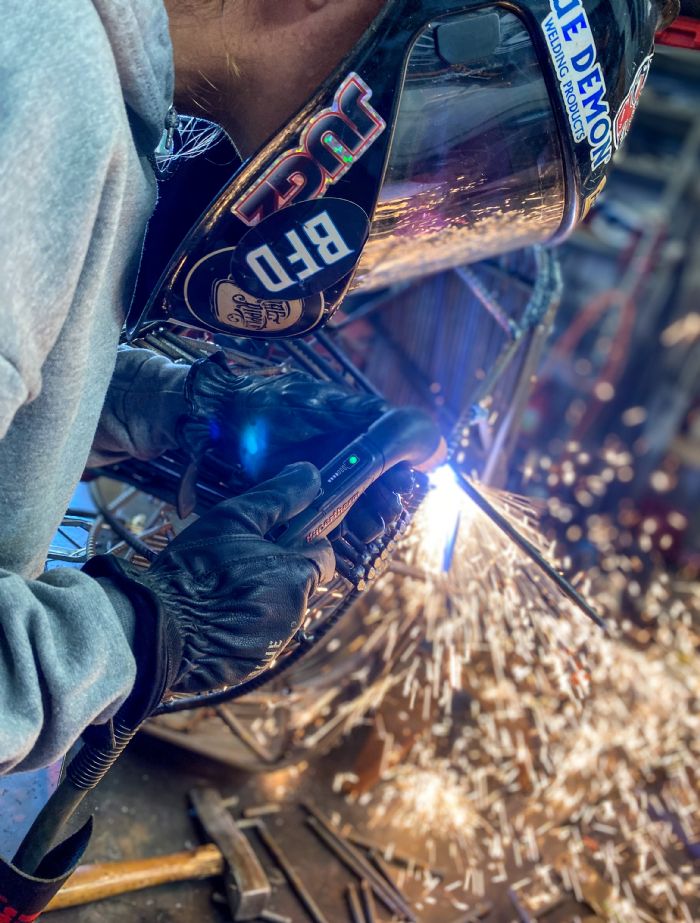 Matching
her artistic passion is a drive that led Ripple to self-learn metal
fabrication, and parlay that into a host of endeavors from her base in
Big Spring, TX. Just witness her artistic and fabricating prowess across
Instagram and other social media platforms, and in the new Netflix
series Metal Shop Masters. You may have viewed her work at FABTECH this
past September, where Hypertherm showcased her fabricated metal
butterfly wings.
Matching
her artistic passion is a drive that led Ripple to self-learn metal
fabrication, and parlay that into a host of endeavors from her base in
Big Spring, TX. Just witness her artistic and fabricating prowess across
Instagram and other social media platforms, and in the new Netflix
series Metal Shop Masters. You may have viewed her work at FABTECH this
past September, where Hypertherm showcased her fabricated metal
butterfly wings.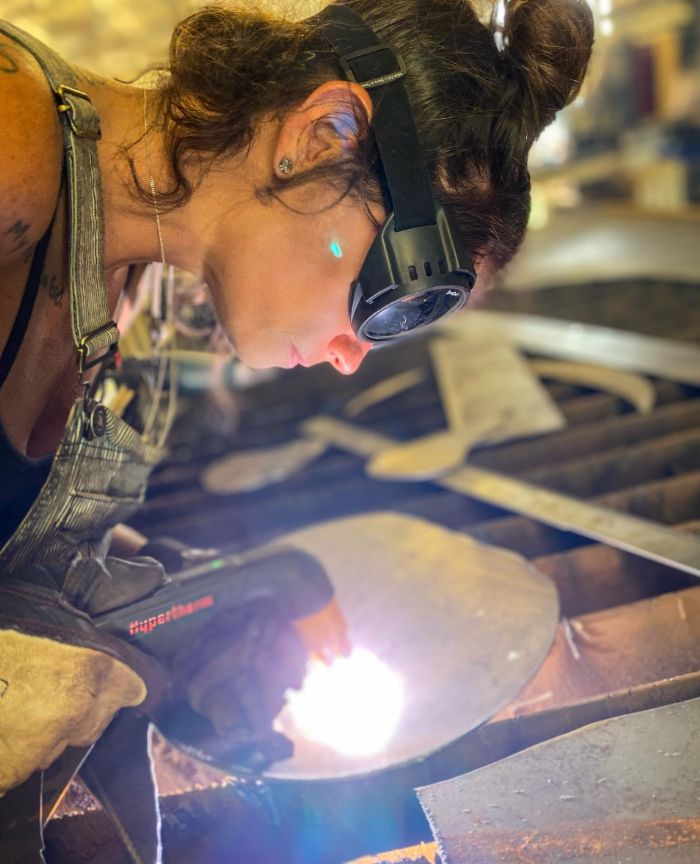 The latest tool in Ripple’s toolbox: a Hypertherm Powermax65 Sync plasma-arc-cutting (PAC) power supply, outfitted with Hypertherm’s new SmartSync torch technology. A major key to the system: replacement of the traditional multiple-piece consumable stack with a single-part cartridge, color-coded by the type of application, such as yellow for hand cutting. Technology embedded in each cartridge automatically sets the correct amperage, air pressure and operating mode, according to Hypertherm officials, and the Sync system indicates when cartridge replacement is required. Additionally, SmartSync hand torch controls allow operators to adjust the amperage and change the cartridge without returning to the power supply.
The latest tool in Ripple’s toolbox: a Hypertherm Powermax65 Sync plasma-arc-cutting (PAC) power supply, outfitted with Hypertherm’s new SmartSync torch technology. A major key to the system: replacement of the traditional multiple-piece consumable stack with a single-part cartridge, color-coded by the type of application, such as yellow for hand cutting. Technology embedded in each cartridge automatically sets the correct amperage, air pressure and operating mode, according to Hypertherm officials, and the Sync system indicates when cartridge replacement is required. Additionally, SmartSync hand torch controls allow operators to adjust the amperage and change the cartridge without returning to the power supply. 